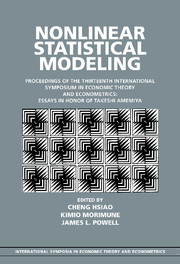 Nonlinear Statistical Modeling
Nonlinear Statistical Modeling Published online by Cambridge University Press: 05 June 2012
Introduction
Perron (1989) developed unit root tests which allow for a break in the deterministic trend. The Perron test is asymptotically similar. Related tests have also been suggested by Schmidt and Phillips (1992), Oya and Toda (1998), Bhargava (1986, 1996), and Kiviet and Phillips (1992). In this chapter, we extend the Perron unit root tests to allow for multiple breaks in the trend and investigate both their asymptotic and finite sample properties.
Zivot and Andrews (1992) have studied the unit root test when the location of a break point is unknown. They used the t ratio associated with the lagged dependent variable to find the break point. However, the null distribution requires no break in the trend function. Vogelsang and Perron (1998) used the t ratio of the discontinuous trend variable to find the break point. Hatanaka and Yamada (1997) used the residual variance to find the break point, and extended the Zivot–Andrews test so that the null hypothesis allows a discontinuous trend. Break points resulting from these tests may conflict with common knowledge, since researchers have rough ideas on when the break actually happened. The Perron test may be applied by setting a wide break interval that possibly covers a break point through the use of shock dummy variables.
In Section 2 we propose a unified framework for the unit root tests that allow for multiple breaks in both the intercepts and trend coefficients as in the Perron C model, for multiple breaks in intercepts only as in the Perron A model, and for joined trend lines as in the Perron B model.
To save this book to your Kindle, first ensure [email protected] is added to your Approved Personal Document E-mail List under your Personal Document Settings on the Manage Your Content and Devices page of your Amazon account. Then enter the ‘name’ part of your Kindle email address below. Find out more about saving to your Kindle.
Note you can select to save to either the @free.kindle.com or @kindle.com variations. ‘@free.kindle.com’ emails are free but can only be saved to your device when it is connected to wi-fi. ‘@kindle.com’ emails can be delivered even when you are not connected to wi-fi, but note that service fees apply.
Find out more about the Kindle Personal Document Service.
To save content items to your account, please confirm that you agree to abide by our usage policies. If this is the first time you use this feature, you will be asked to authorise Cambridge Core to connect with your account. Find out more about saving content to Dropbox.
To save content items to your account, please confirm that you agree to abide by our usage policies. If this is the first time you use this feature, you will be asked to authorise Cambridge Core to connect with your account. Find out more about saving content to Google Drive.